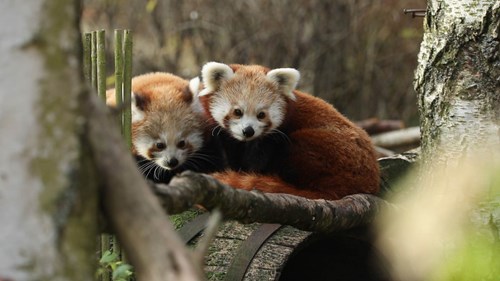Red-y for their debut
08/11/2017 in Highland Wildlife Park

Red panda kits N’mai and Nam Pang have begun emerging from their den and have started to venture out into their enclosure giving visitors to RZSS Highland Wildlife Park their first peek at the pair.
The male kits were born on 14 June to mum Kitty and dad Kevyn and now at five months old, the duo have started to spend time outside of their den, exploring and playing.
Douglas Richardson, Head of Living Collections at RZSS Highland Wildlife Park, said:
“This is our third litter of red pandas born at RZSS Highland Wildlife Park since the arrival of our adult pair in 2012, with a male born in 2013 and a male and female in 2014. Although born in June, most other carnivore babies would be routinely bumbling out of the nest-box by the time that were four to six weeks old, but red panda babies are very slow to reach that exploratory stage.
“Our red pandas are part of the European Breeding Programme and the birth of N’mai and Nam Pang is a direct result of a specific breeding recommendation from the species coordinator who is based in Rotterdam Zoo. These are our first kits in two years due to strictly controlled breeding as a result of the limited availability of space in zoos for enclosures which are able to fulfil the needs and requirements of this unique species.
“It may seem counter intuitive to limit the reproduction of a threatened species, but as is the case with the red panda, reintroduction is not currently possible or recommended due to the ongoing threats to the species in the wild and other factors. Zoo-based breeding programmes are there to ensure the longevity of the species in our care.”
The kits have been named N’mai and Nam Pang after rivers in northern and eastern Myanmar. This follows the Park’s tradition of naming red pandas born there after geographical features in and around the species’ wild range.
The red panda is more at risk in the wild than its namesake the giant panda, with conservation efforts (including those of RZSS) helping the giant panda move from endangered to vulnerable on the IUCN Red List last year. It is hoped that similar efforts with the red panda will see the species’ decline reversed.
Red pandas are native to the Nepal, Bhutan, north east India, Myanmar and south-central China. The name "panda" comes from the Nepalese word "nigalya panya", which means "bamboo eater".
Listed as endangered on the IUCN Red List, their global population is estimated to be lower than 10,000 individuals and continues to decline as a result of habitat loss and fragmentation, as well as poaching and incidental trapping.
Featured Articles

An update from the Budongo Forest
19/04/2024 in Conservation

Edinburgh Zoo named best zoo in Scotland
15/04/2024 in Edinburgh Zoo

























Follow EZ